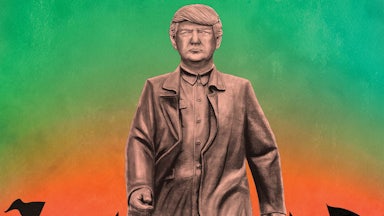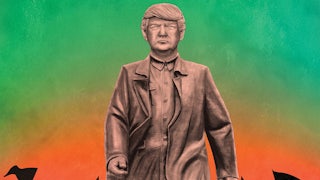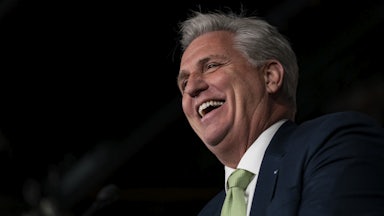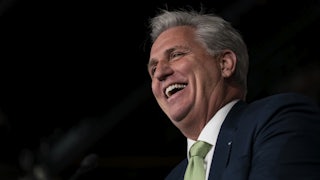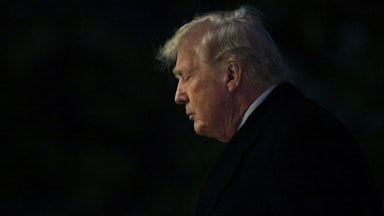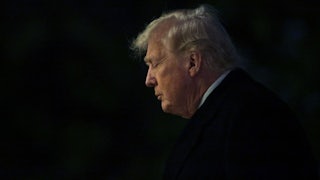What was the weirdest thing that Donald Trump did on Saturday, the twentieth anniversary of 9/11? It is not immediately obvious. While the four other men who served as president during the twenty-first century attended ceremonies honoring the dead, Trump spent the day as only he could, which is to say he dawdled through the day in the crassest manner imaginable.
He recorded a video message for the Korean Unification Church—the religious cult better known as the Moonies and best known for its mass arranged marriages and strict regulation of its members’ sexual and private lives—in which he lavished praise on the organization, referring to it as an “inspiration.” He also bizarrely claimed that his election had magically brought peace to the otherwise volatile Korean peninsula. “Looking back today, it’s easy to forget how dangerous the situation was when I was elected,” Trump said. “Missiles were flying, nuclear weapons were being tested, and powerful threats were being issued every single day. Under my leadership, the United States adopted a policy of unprecedented strength doing more than any prior administration.”
Then, not to be outdone, he provided pay-per-view color commentary on a TikTok competitor for a fight—if you can even call it that—between a nearly 60-year-old Evander Holyfield and 44-year-old MMA fighter Vitor Belfort. Trump mostly talked with his co-commentator, excitable lackwit son Donald Jr., about the good old days, Holyfield’s once shockingly speedy punches, and Larry Holmes’s immaculate left jab. On Saturday, the 58-year-old Holyfield could barely punch and was roundly pummeled by his comparatively sprier opponent, in a match that should have been disallowed via the Geneva Convention.
While Trump snubbed official events commemorating 9/11, he did make an appearance at a New York City police station, where he lambasted the Afghanistan withdrawal he had set in motion. “It looked like we retreated, it looked like we gave up. Like, they use the word surrender,” he whined, adding that the administration was “fleeing” Afghanistan.
As Politico’s Ruby Cramer wrote, September 11 was a microcosm of Trump’s post-inauguration world: “A parallel reality of Trump’s own devising—his own strange vacuum, designed to entertain, or outrage, in which he was free to lace every appearance with a self-serving narrative, unencumbered by traditions of nonpartisanship, or the presence of unwelcome rivals.” It is, in some ways, reminiscent of Trump’s bizarre and freewheeling 2016 campaign: He is certainly more consumed by bitterness than ever before, but he’s as strange and as boorish as ever, and transparently buckraking on 9/11 in the weirdest way imaginable.
For mainstream media outlets, which endlessly covered Trump’s 2016 campaign as a strange and (for them, at least) lucrative spectacle, Trump’s fitful public reemergence is something of a test. The former president remains the most important Republican in the country; the GOP, so hastily remade in his image, remains that way even now. If he chooses to run in 2024—and he now regularly previews his plans to do so and is building the exact kind of campaign organizations that prospective presidential candidates install in the lead-up to primary season—he will be the prohibitive favorite. Republicans have no clear challenger, and many of his potential successors are likely to bow out of the race rather than face him and risk damaging their standing in the Republican Party.
It renews an old conundrum. Trump is doing vile and odd things on a daily, if not hourly basis. Ex-presidents normally spend their time raising money for their presidential libraries and favorite charities. Trump’s predecessor seems intent on building a media empire of some kind. Ex-presidents don’t tend to raise much of a ruckus, but it’s the only way Trump knows how to live. His activities are inherently newsworthy and yet also, at heart, distractions or pseudo-events. But having ascended to victory thanks to media reliably covering his antics in 2016, it makes sense that he’ll try it again in 2024.
For the moment, the political sideshow he’s staging hasn’t really transcended their seriocomic boundaries. The press has remained focused on stories with more merit and public interest, whether it’s about the Afghanistan withdrawal or the Democrats’ effort to pass a budget and an infrastructure package. Trump has tried to make himself a part of these stories but seems to be struggling without his Twitter account offering him a regular opportunity to interject.
It’s been an altogether more disciplined display from the press, who’ve rarely placed Trump at the center of these bigger conversations. While Trump dead-enders exist throughout the media-sphere, it’s starting to look like many in the news industry are tired of the guy. The Trump roller-coaster was very good for business, but no one seems ready to follow the former president’s cue and race to climb back aboard. That may very well not hold for long. Trump’s rallies will pick up as we get closer to the midterms, and he’s already starting to build a real campaign infrastructure. The more the “Trump’s running” story takes on substance if its own, the more the pressure to cover Trump’s every movement will grow. And realistically, it should: He may once again vie to be the leader of the free world. But media now has time to think deeply about those prospects and make some key decisions on how it will cover that inevitable presidential campaign.

